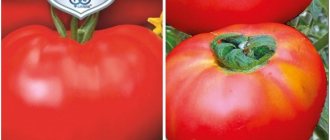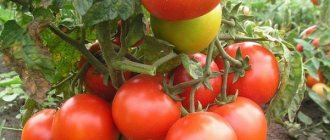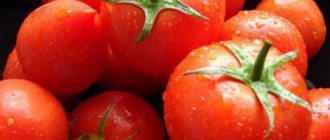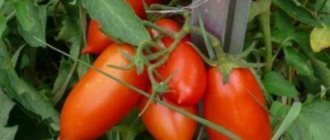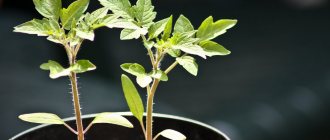» Vegetable growing » Tomatoes » Tomato variety Ural giant
0
1168
Article rating
The Ural giant tomato is a large-fruited variety that is grown in four different colors. Tomatoes grow tasty, bright and beautiful - they become a real decoration of the table. But to get a good harvest, you need to know the characteristics of this crop, its advantages, disadvantages and rules of agricultural technology.
- Advantages and disadvantages
- Landing
- Sowing
- Seedling
- Transfer
- Care
- Diseases and pests
- Adviсe
- Reviews from gardeners
Tomato variety Ural giant
Collation of varieties
The variety belongs to a new generation among large-fruited ones, and includes 4 species.
They differ from each other only in the color of the fruit. They can be not only pink or red, but also orange and yellow. Each variety has its own special taste, smell and characteristics. Red fruits contain a lot of lycopene, which is very beneficial for our body. The fruits are pink in color (and) also taste sweet. Yellow vegetables have a more piquant taste, while orange ones have more than enough carotene.
Compared to other large-fruited varieties, this variety can be classified as early ripening. Burning bush is indeterminate and liana-like. The height is up to 1.5 m. Therefore, they require a garter.
Description and characteristics of the variety
Tomato Giant is an indeterminate tall variety. Powerful bushes grow up to 1.5-2 m.
Plants are characterized by semi-spreading shoots and moderate foliage. They require garters and shaping.
Ripening time is average - 125 days from germination. The huge fruits weigh in the range of 600-700 g. Many specimens from the lower branches reach 1.2 kg.
Tomato "Aelita" Giant is characterized by raspberry-pink tomatoes with bright juicy pulp. At the break they are meaty and sugary. The taste harmoniously combines sourness and sweetness.
Which regions are best to grow in?
The tomato is intended for various areas and is grown:
- in moderate stripes under the film;
- in the south in open beds;
- in the northern regions in heated greenhouses.
Method of use
Giant tomatoes are especially tasty in salads and fresh slices. Also used for:
- pastes and juices;
- hot dishes;
- sauces and ketchups;
- canning in pieces;
- drying in slices.
Origin of giant tomato varieties
When developing varieties of giant tomatoes, the main goal of breeders was to achieve larger sizes and improve the taste of the fruit. As a result, tomatoes with large fruits and an original sweet taste have been developed. The pulp of giant tomatoes is pleasant to the taste and contains an increased amount of sugars, lycopene and provitamin A.
Perhaps the disadvantage of giant tomatoes can be considered the specificity of their use - for salads and processing for juice. They are not suitable for preservation due to their size; their shelf life is generally not great. The weight of the “giant” fruit usually ranges from 200 to 500 grams. And for growing in a garden or summer cottage - interesting, exciting and appetizing.
The characteristics and description of the variety indicated on the packaging must be read before purchasing seeds - fundamental points may be indicated there. Prepare the seeds for planting - disinfect them in a solution of potassium permanganate, rinse them in warm water and put them in a cool place for several days. Next, the seeds are soaked, and when the first shoots appear, they are planted in prepared pots.
The most important thing when deciding to grow a giant tomato is to purchase high-quality selection seeds. In Moscow there are representative offices of almost all companies involved in the licensed sale of seeds.
Growing giant tomatoes is not particularly difficult. Many varieties are suitable both for open ground in the southern regions and for growing in Siberia in greenhouse conditions.
The requirements for seeds, seedlings, planting time and plant care are similar to other varieties.
An important feature of successful cultivation of giants is the obligatory timely staking of the stem, topping and pinching of the plant. Depending on the desire to get fruits of a certain size, it is necessary to form a bush. Usually 2 stems are left, but for growing particularly large specimens - only 1 stem. As the fruit grows, be sure to strengthen the branches with stands.
Advantages and disadvantages
Summer residents have managed to appreciate this variety for its very good taste and productivity. Caring for them requires some effort, but the result will live up to expectations.
Ural giant tomatoes weigh at least 500 g each
pros
- excellent taste;
- large-fruited, attractive tomatoes;
- good yield;
- the skin is thin, but the tomatoes do not crack;
- the variety is adapted for cultivation in different regions;
- perfect for homemade preparations.
Minuses
- immunity is average;
- you need to take stepsons and form a bush;
- plants must be tied to a support;
- keeping quality and transportability are not at the highest level;
- Ural giant tomatoes are not suitable for whole-fruit canning.
Advantages of the variety
Salad tomatoes vary in color, they are sweet in taste, with fleshy pulp. The characteristics and description of the variety of classic giant tomatoes are associated with resistance to cracking and high temperature. To experience the full flavor palette of tomatoes, it is recommended to plant all 4 color varieties.
Description of fruits:
- The pulp of the fruit is sugary, like that of a watermelon, grainy at the break, juicy, melts in the mouth.
- Red tomatoes contain record amounts of lycopene.
- Pink tomatoes have a rich, sweet taste.
- The orange and yellow fruits, which have a rich, piquant taste, contain carotene.
The declared varieties are presented on the agro market, which creates healthy hybrids for cultivation in Siberia and the Urals under risky farming conditions.
The Ural Giant variety attracts vegetable growers with its high adaptability to weather conditions and microclimate. Plants have ecological plasticity, so it is proposed to grow the crop in any region where it is possible to cultivate the soil.
The variety's resistance to low temperatures allows it to be grown in open ground in cold regions of the country. At the same time, the adaptation of the crop to elevated temperature conditions allows the variety to be grown in hot greenhouses and in the open air of the southern part of Russia.
The Ural giant is characterized by medium fruiting periods, because the formation of large tomatoes is associated with a lot of time. Bushes with unlimited growth potentially provide the plant with high productivity.
During the growing season, a powerful trunk is formed; the plant reaches a height of 1.5-2 m. On the bush there is a constant desire to form and develop new flower stalks. On 1 cluster, 3-5 ovaries are formed, from which fruits of a round shape with slight ribbing develop.
When cut horizontally, many chambers with seeds are observed. Tomatoes of the Ural Giant variety reach a weight of 800 g. Salad-type tomatoes are not intended for long-term storage, so it is recommended to process part of the harvest in time into tomato paste and lecho.
Among the advantages are the following:
- If you care for the bushes correctly, then up to 15 kg of vegetables will be harvested per square meter during the season.
- Since the bushes are mature, up to 5 ovaries can form on one brush. This allows for very efficient use of space.
- The fruits have a good aroma and taste.
- Although the vegetables are large, they crack extremely rarely.
- They tolerate both extreme heat and cold well.
The disadvantage is susceptibility to diseases and many pests. Plants suffer from late blight and other diseases. In addition, fruits are inconvenient to transport over long distances.
Care
Tall bushes are formed into 1 or 2 stems, removing side shoots. When the plant reaches the desired height, pinch out the growing point.
The stems are tied to a trellis, but also clusters with heavy fruits. The number of flowers is normalized as needed (the fewer flowers, the larger the fruit). Water the plants once a week - with warm water at the root.
():
Large-fruited varieties are characterized by the phenomenon of fasciation - the fusion of several flowers and the appearance of a large single double flower. From such a flower a huge, often ugly-shaped fruit develops, which delays the appearance of other fruits and significantly reduces their size. Regularly inspect flowers on tomatoes and remove double ones.
After watering, the soil is well loosened and weeded. To retain moisture in the soil and reduce the number of weeds, the bed can be mulched (peat, hay, dry leaves, etc.).
The large-fruited variety needs frequent fertilizing - they do it once every two weeks, alternating organic fertilizers with mineral complexes. They can be combined with watering using liquid or water-soluble fertilizers. If there is a deficiency of certain minerals (which can be seen by the appearance of the plant), foliar feeding is used to help compensate for the deficiency in the shortest possible time.
The most popular tomato varieties among giants
Large-fruited tomatoes today are represented by a wide variety of varieties with vegetables of various shapes and colors. Varieties and their hybrids have also been bred for cultivation in any climatic zone.
The early-ripening determinate tomato variety “Crimson Giant” was bred by a group of breeders led by Lukyanenko and entered into the State Register in 2007. Characteristics:
- full ripening occurs after 100 - 110 days;
- yield from 6 to 8 kg per 1 sq.m; average susceptibility to the most common diseases;
- low shelf life and transportability.
| It is grown in all regions of the Russian Federation in carbonate and film greenhouses, and in the southern regions in open ground. |
A non-standard branched bush with a height of 0.7 to 1.5 meters requires mandatory formation and pinching. A well-formed root system grows laterally in the upper layers of the soil.
Large leaves of a dark green color with slight wrinkles have a regular shape.
Inflorescences of the intermediate type are placed every 2 leaves, starting from the first 5-6 leaves. Typically, up to 4 fruits are formed on each inflorescence, with at least 1 being quite large. Tomatoes that hold tightly to the stalk are not susceptible to shedding.
The fruits of the “Crimson Giant” have an irregular flat-round shape with a diameter of about 10 cm. There is a slight ribbing from the stalk. When ripe they have a pink tint, the stalk is surrounded by a greenish spot. The ripe fruit is a rich crimson color. The weight of a tomato is usually 200 - 400 g, and on the lower inflorescence it can reach up to 1 kg.
The pulp is tender, fleshy, with a small number of grains, tastes sweet with the presence
slight sourness. It is eaten both fresh, in salads, and for making juices, pastes and ketchups. Self-harvesting of seeds is possible.
Bred in 2010 by Siberian breeders. Tomatoes “King of Giants” are indeterminate varieties with an average ripening period.
Developed for cultivation in open ground in the southern regions and in greenhouses in the middle and northern regions.
Characteristics:
- ripening period 110 - 120 days;
- yield from 7 to 9 kg per sq.m;
- low susceptible to pests and diseases;
- easy to care for;
- good keeping quality and transportability.
Bushes 1.7 - 2 m high require constant pinching and gartering. The best yield results are achieved when forming a bush of 1-2 stems.
The round, slightly flattened, bright red fruits reach a weight of 400 - 600 g, but specimens weighing up to 800 - 1000 g are not uncommon. The skin is dense and not susceptible to cracking. The fleshy and juicy pulp has a sweet taste with barely pronounced sourness, and when overripe, even sugary.
This variety is distinguished by its high content of vitamins and is recommended for preparing children's and dietary dishes.
The Sugar Giant is undemanding in care, is resistant to weather changes and sets fruit well, regardless of the climate. The “Sugar Giant” tomato belongs to the indeterminate standard mid-early varieties. Brought out in 1999 by Russian breeders and entered into the State Register in 2000 as a variety for cultivation on open ground and in greenhouses.
Characteristics: ripening period 110 - 115 days;
- yield 15 - 18 kg per square meter. m;
- tolerance to temperature changes and lack of moisture;
- decent disease resistance.
A plant 1.2 - 1.5 m high with a strong stem requires garter with supports and pinching.
The first ovary is formed above the 9th leaf, the rest after 2-3 leaves. Tomatoes are pink-red and have a round, slightly elongated shape. The weight of a ripe tomato is 350 - 450 g. Specimens weighing up to 800 g are not uncommon.
The juicy pulp with a sweet taste has a high content of sugars and lycopene. Suitable for fresh consumption and for making juices and sauces.
The “Giant Red” tomato was bred by amateur breeders in 1989 and entered into the State Register as a plant for greenhouses and open ground. The mid-early tomato variety is an indeterminate standard species.
Characteristics:
- ripening period 100 - 105 days;
- yield up to 12 kg per square meter. m;
- resistance to the most common diseases;
- tolerance to lack of moisture;
- poor keeping quality;
- pickiness about soil composition.
A bush with long drooping leaves 140 - 180 cm high requires mandatory formation and pinching. The trunk must be tied up, and supports are required under the branches. The first ovary is formed after the 10th leaf, the rest after 3 leaves. The cluster is simple, 5-6 fruits each.
Large, slightly flattened, rounded fruits with slight slight ribbing acquire a bright red color when ripe. The weight of a tomato is 450 - 650 g, and on the lower clusters it can reach 700 - 850 g. The pulp, saturated with juice, has excellent taste and a high content of provitamin A and sugars.
Suitable for fresh consumption and for making juices, sauces and ketchups.
The “Angela - Giant” tomato is included in the assortment of collectors of Russian gardeners and belongs to the indeterminate mid-season varieties. Bred for cultivation in greenhouses, closed ground and film coverings.
Characteristics:
- ripening period 100 - 130 days;
- yield 8 - 10 kg per square meter. m;
- unpretentiousness;
- high resistance to diseases;
- good keeping quality.
A plant with a height of 1.4 - 2 m must be formed and subsequently planted. The trunk must be tied up and supports placed under the branches.
| To grow especially large fruits, 1 trunk is formed and the number of ovaries is regulated. |
The fruits are flat-round, medium ribbed, and have a deep red color. Weight ranges from 300 to 1000 g, and if desired, specimens of 1.5 - 2 kg can be grown. The fleshy, sweetish-tasting pulp with a small amount of seeds is suitable for salads, sauces and baby purees.
The variety “Giant Novikova” was registered in the register in 1990 as a mid-season tomato for cultivation in film greenhouses. Plant of indeterminate standard type with regular foliage.
Characteristics:
- ripening 110 - 120 days;
- yield 15 - 20 kg per sq.m;
- average resistance to diseases;
- average keeping quality;
- pickiness about soil composition.
To grow large fruits and a good harvest, the bush should be formed into 1 stem with a mandatory vertical garter and stepsoned in a timely manner. The author of the variety, A.I. Novikov himself, collected up to 30 kg from one bush.
| The flat-round, strongly ribbed fruits are pink with a raspberry tint. They usually weigh 500 - 600 grams, but kilogram specimens are not uncommon. |
The juicy, sugary pulp is great for making juices and sauces, and the sweet tomato itself is excellent fresh and in salads.
The “Spanish Giant” tomato belongs to the mid-late indeterminate varieties and is recommended for cultivation in open ground and in greenhouses.
Characteristics:
- maturity 110 - 120 days;
- yield 10 - 12 kg per square meter. m;
- thermophilicity;
- average resistance to diseases;
- pickiness to temperature changes;
- excellent keeping quality and transportability.
A bush 2 - 3 meters high needs shaping, vertical garter, pinching the top and pinching. The average weight of the red oval fruits is 250 - 350 g. The juicy pulp with a considerable amount of dry matter has an excellent taste.
| Tomatoes are consumed fresh and in salads. |
The Leningrad Giant tomato is an early-ripening variety for film greenhouses. A determinate plant with large carved leaves reaches a size of 80 - 95 cm.
Characteristics:
- maturation 85 - 90 days;
- yield 8 - 12 kg per square meter. m;
- average resistance to diseases;
- thermophilicity.
| The first simple inflorescence is formed above the 7th leaf, then after 1 - 2 leaves. The flat-rounded fruit with slight ribbing has a pink color when ripe. |
The sugary, juicy pulp has a rich dessert taste. They are consumed fresh, in salads and used to make sauces, ketchups, pastes and desserts.
Tomato Yellow Giant
The mid-season tomato variety “Yellow Giant” was bred by breeders. The indeterminate plant can grow in open ground and in greenhouses.
Characteristics:
- ripening 110 - 122 days;
- yield up to 15 kg per sq. m;
- recommended for allergy sufferers and baby food;
- bears fruit for 1.5 months;
- poor keeping quality.
Bushes 1.2 - 1.7 m high need shaping, staking and pinching. The fruits are flat, round and yellow in color, reaching a weight of 300 - 400 g.
The pulp, rich in juice, sweetish in taste, with a high content of niacin, is useful for heart patients and people with liver disease.
The “Ural Giant” tomato belongs to the mid-season type and is represented by a series of four identical varieties, differing in the color of the fruit. Successful adaptation to the climate of various regions from the south to the north has brought the “Ural Giant” well-deserved popularity among gardeners.
Characteristics:
- maturity 110 - 120 days;
- yield 10 - 15 kg per square meter. m;
- excellent adaptation to weather conditions;
- poor keeping quality.
An indeterminate type bush with a height of 1.5 - 1.8 m requires mandatory shaping, vertical staking and support of branches, topping and pinching.
The fruits are rounded and flattened with slight ribbing. The weight of a tomato is 700 - 800 g, but specimens can be grown up to 1.5 kg. The pulp at the break is granular-sugar, juicy, sweet in taste.
| The red variety stands out among others due to its high lycopene content. The pink tomato has a unique sweetness. Yellow (lemon) and orange varieties are rich in carotene and have a rich, piquant taste. |
Important Details
It is worth noting some characteristic features of the variety.
Fruiting dates
In various sources, the description of the variety differs in detail - it is called either early or mid-season. In essence, there is no contradiction here. Naturally, such a large tomato cannot be early ripening.
The Ural giant is characterized by medium ripening periods. On the other hand, usually such “heavyweights” are mid-late. And in this weight category, relative to others, we can talk about relatively early dates.
Plant dimensions
Indeterminate type of bush, which provides the plant with the highest potential yield. Over the course of a season, the bush grows almost as tall as a person, reaching one and a half meters in height.
The trunk is very powerful, with a constant desire for continuous development, the formation of more and more new brushes. By their primordial nature, tall tomato bushes are close to vines and “lie down” under the weight of the harvest if they are not tied up in time.
Harvest quality
The fruits really grow to gigantic sizes. The 700–800 grams promised by the manufacturers is far from the limit. One brush can bear 3 – 5 ovaries. Each tomato is round in shape, with a flattened top. Multi-chambered, moderately ribbed.
Vitamin diversity
It is very convenient for summer residents that the variety is offered in four color variations. Each owner can make a choice according to his taste, or better yet, plant all four! In addition to aesthetic pleasure, there are tangible benefits. You will get a whole palette of flavors, a complex of vitamins and other biologically active substances.
Taste sensations
The pulp of the Ural giant is of the “watermelon” type, granular and sugary at the break, moderately juicy, melting in the mouth. The taste is amazing, truly sweet.
Another valuable feature is the real “tomato” aroma. These tomatoes make the most delicious fresh salads. Just one tomato and you have a bowl of salad for the whole family.
Landing
Before planting, you need to add fertilizer to the soil. This should be done at the end of autumn. Wonderful fertilizers are such natural accumulations as bird droppings and wood ash.
Already formed seedlings are planted in the ground. It is prepared in advance, sowing the seeds by the end of March, deepening them 1 cm into the rock. After the true leaves appear, they are planted separately.
Before planting, you need to harden the plants by taking them outside for 2-3 hours every day for a week. Seedlings can be planted in the greenhouse as early as May. In this case, the age of the plants should be deserted (= sparsely populated) less than 2 months. You can plant them in the beds only after you are sure that there will be no more frosts. The plant must have more than 5 leaves and one raceme. Fertilizers should be placed in each hole.
Features of cultivation
Seeds for seedlings are sown in the second half of March (the deadline is early April). The soil can be used either purchased or your own - for example, turf soil with compost and humus (2:1:1). It is pre-treated in potassium permanganate or in a solution of pharmaceutical hydrogen peroxide, then spilled with water. The seeds are kept in a growth stimulator - “Zircon”, “Epin”, “Kornevin”.
They are sown to a depth of 1.5 cm, maintaining a distance of 2 cm between plantings and 5 cm between grooves. Grow with plenty of moisture under film or glass, monitoring a constant temperature (24-25 degrees). They dive after 2-3 leaves appear, then give complex fertilizer. Harden off 7-10 days before transplanting into the ground.
At the end of May or early June, Ural Giant tomato seedlings are transferred to a greenhouse (interval 50-60 cm). Further care for them includes the following actions:
- Regular, abundant watering (1-2 times a week, 7-10 liters per adult plant).
- Apply complex fertilizer once every 2-3 weeks.
- Stepping and forming a bush into 2 stems. To do this, leave a sprout that appears in the axil of the leaf located under the first flower raceme. It can also be formed into 1 stem - then all the stepsons are removed.
- Mulching, weeding, loosening the soil.
- Tying - it is optimal to hang a horizontal trellis and put a rope around which the tomato branches will cling.
It is important to choose the appropriate method for gartering bushes for tomatoes.
Tomato "Ural Early": surprise with ease and ease of care
It is difficult to call this information official and reliable, since the variety is not included in the register of breeding achievements of the Russian Federation. The true origin of the tomato variety is unknown.
The variety came to the market under the patronage and tag “Northern Vegetables”. The company itself does not have information about the variety and cannot explain its origin.
Variety information
Since the variety has not been tested at variety testing stations under the supervision of specialist breeders, the information can only be partially trusted.
The variety is presented as determinate, low-growing, standard. Those vegetable growers who fell for the picture and grew it describe the plant as being up to 50 cm high with a small leaf blade.
The central shoot of the vegetative form is very persistent. The plant looks like a small tree. The fruits are formed in spreading clusters.
An early ripening variety provided that seedlings are sown in early March.
The fruits are round and flat-round in shape, not large, but not cherry. During the period of full biological maturity, rich red color. When cut, it is clearly visible that the flesh is dark red in color.
The tomatoes are a good size to fit into the mouth of the sealing jar. However, there is no information about how exactly the variety behaves during heat treatment.
When considering Ural Early tomatoes, reviews regarding sustainability are not clear.
Those vegetable growers who grew tomatoes in greenhouses talk about the extreme resistance of the variety, but in open ground, tomato bushes were the first to be affected by late blight and it was not possible to get at least some harvest.
Experienced vegetable growers do not rely on the mercy of nature and are well aware that there is not a single completely resistant variety, therefore preventive treatments are the basis for the well-being of the crop.
For Ural Early, the most preferable treatment scheme will be the following:
- First treatment after planting in open ground;
- The second in 15-20 days;
- The third again in 15-20 days
- Then every 10 days after harvesting, with preparations with a short waiting period after treatments.
To get a high-quality harvest you need:
- Select disease-resistant varieties;
- Carry out preventive treatments regardless of the variety;
- The frequency of treatments should be compared with weather conditions;
- Do not use the same fungicidal preparations for many years;
- During the season, carry out alternating treatments with drugs of different directions with different active principles.
Among the advantages, vegetable growers talk about:
- early harvest;
- ease of care;
- the uselessness of stepsoning;
- no need for supports;
- it is unnecessary to tie up shoots and inflorescences;
- good taste.
Unfortunately, the shortcomings are also obvious and they have done their job. There is information that some vegetable growers have introduced varieties that “I will never sow again.”
The main reasons for such dissatisfaction with “Ural Early” are the following:
- low yield;
- high sensitivity to diseases;
- unprofitability of growing in greenhouses and greenhouses.
Vegetable growers in the southern regions can afford to sow early tomato seeds directly into open ground. However, this is not acceptable for farmers in the Urals and cultivation must begin with seedlings.
The seedling period of this variety is no different from all others. The seed is soaked, warmed and sown. Many gardeners practice growing low-growing tomatoes without pinching and without individual containers, and they are absolutely right.
Seedlings of this variety will not take up much space on windowsills, they do not outgrow and do not require additional handling.
It is necessary to plant in the garden at a time when the threat of return frosts has completely passed. It can be planted in greenhouses earlier, but there is no point in taking up expensive space with this variety.
When choosing a landing site, the following conditions must be taken into account:
- the area should be the sunniest;
- you can choose any predecessor except nightshade;
- select soils that are light, air-permeable and water-permeable;
- The acidity of the soil should not be high.
If the soils are sufficiently fertile, then the variety will not require special fertilizing. The removal of nutrients by the variety is not large, due to its small fruit and low yield.
Tomato "Ural Early" reviews, yield and all available information are very ambiguous, so there is no need to sow a lot. By sowing a few seeds and growing bushes, you can understand whether such a tomato is needed in the garden or whether it is better to choose another one.
The Ural region is large, but breeders are trying to develop varieties that would satisfy the most demanding vegetable growers and they need to be used.
To get a good harvest, you need to tie up the bushes, shape them, water them on time, apply fertilizer and warn against diseases.
Formation
- The bushes are constantly growing, and therefore require formation according to the season. If this is not done, the yield will be low. It is necessary to fire the stepchildren and carry out topping.
- If the plants are well supplied with nutrition, then it is allowed to leave 1 stepson above the first brush. When the bush reaches a height of more than 150 cm, you should pinch the top. In this case, you need to stop several leaves above the brush. Pinching will allow the plant to spend energy only on top of the fruit.
Garter The fruits grow large, so the bush must be tied up. (It is convenient to use vertical trellises. The bush is wrapped around, and the brushes are tied separately separately.
Watering Watering should only be done with warm water. This needs to be repaired after dark. Water every 2 days, in moderation.
Fertilizers should be applied during the season, at least every 2 weeks. Both mineral and organic fertilizers are useful. If you do not apply fertilizer regularly and in sufficient quantities, you will not be able to grow fleshy and large fruits.
Ural character
The declared varieties are presented on the seed market in agro packaging, in the “Ural Summer Resident” series. The company's head office is registered in Moscow, but has close ties with breeding and seed-growing organizations in the Urals, in particular the Chelyabinsk region.
The Miass-sortsemovosh enterprise located here is reviving the best Soviet traditions of seed production. The Chelyabinsk branch of the Research Institute of Fruit and Vegetable Growing and other agricultural structures are involved in the work.
does not bother itself with worries about including the varieties it distributes in the State Seed Register. This does not prevent them from gaining increasing popularity among amateur vegetable growers from all over the country. People are attracted by the stated high adaptability of varieties to a variety of weather conditions and any microclimate. Plants are genetically endowed with high ecological plasticity.
For example, Ural Giant tomatoes are proposed to be grown in any region of the country where farming is possible. This variety can be successfully poured in the harsh conditions of the Urals, Altai, Siberia, North-West, and Moscow region. Its endurance to cold snaps allows it to please owners even in open ground, although in a greenhouse, of course, the return can be even greater. Resistance to high temperatures is also excellent - both in hot indoor ground and in the open air of more southern regions.
Benefits of giant tomatoes
The main advantage of giant tomatoes is the increased content of sugars, carotene and lycopene in the fruit. In addition, giant tomatoes are of the salad type, that is, they have fleshy, juicy pulp, and the sweet taste of the fruit makes them indispensable for fresh consumption and the preparation of juices, ketchups and sauces.
| Disadvantages include the inability to preserve whole fruits and their inability to be stored for long periods of time. |
Even one kilogram giant tomato on the table will look more luxurious than a whole bucket of small tomatoes.
Diseases and pests
Varieties with large and sweet fruits tend to attract various types of pests. For greenhouse tomatoes, the main threat is late blight. To minimize the risk of infection, it is necessary to observe correct crop rotation and take preventive measures in a timely manner.
Adviсe
- You can’t plant tomatoes next to potatoes, and also after peppers and eggplants;
- The soil must be loosened frequently and the beds must be weeded;
- The greenhouse must be ventilated regularly;
- The plantings should not be thickened; excess leaves should be removed from the bushes;
- Do not fertilize the soil with fresh manure;
- It is recommended to disinfect the greenhouse with lime chloride;
- Plants need to be treated with Bordeaux mixture or copper oxychloride, watered with an infusion of ash;
- If there are obvious signs of late blight, you can treat the bushes with oxychome, “Profit” or “Kartotsid” preparations.
Giant tomato
The best varieties of tomatoes for the Urals and Siberia.
fazenda.shop Ural Summer Resident Tomatoes
Prevention
To prevent the development of various fungal diseases, it is advisable to spray plants with Fitosporin, which is safe from an environmental point of view. If the plants are already infected, you need to use special preparations that are sold in stores for gardeners.
Plants of this variety require special and constant care, without which it is impossible to obtain a high yield. Only in this case the fruits will be large, juicy and fleshy, and will have good taste.



